Anime And Food — A Culinary Adventure Like No Other
Food plays a crucial role in the foundation of relationships, whether dining out on a first date, bringing a meal to a friend to celebrate an occasion or lament a loss, and having unlimited permission to eat the foods that make you feel physically and emotionally good. This is the idea that food is more than simply nutrition; it is frequently how we express ourselves and share our lives. Thus, the anime’s menu includes food because anime is a form of expression that encompasses many aspects of the world, not just Japan.
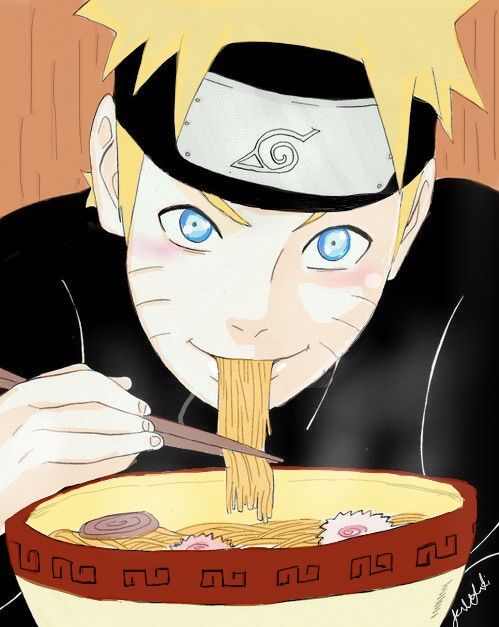
Furthermore, watching anime shows in which our favorite characters demonstrate their culinary prowess is such a great occasion that it makes us want to attempt and recreate those meals at home. There are numerous blogs and websites on the internet that offer recipes for some of the most well-known anime foods. It is entirely normal to identify with the storylines and characters via their love of food since eating plays a role in many of our favorite childhood memories, just like Jean from Attack on Titan who names the popular food — both in anime and in real life — omurice as his most beloved childhood memory.
Most of the time, anime meals represent real Japanese cuisine. Because the food in anime looks so good and is usually drawn skillfully, it makes viewers salivate and want to try the meal at least once or return to dishes they have previously fallen in love with. Food in anime can help us connect more deeply to the fictional worlds and beloved characters we adore, not only because of our innate human fascination with food but also because of our viewers’ connections to some unique narratives and characters.
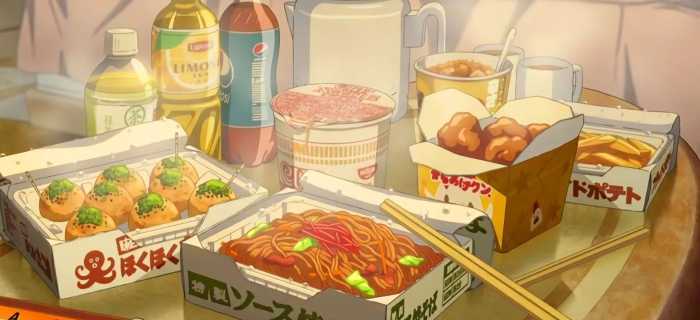
Food is like an ever-present character in anime — from Usagi Tsukino’s iconic love of desserts in Sailor Moon to Suzu’s extreme fondness for sweets in Ayakashi Triangle, which is also effectively used as a diversion plot device, to the name of the equally iconic Dragon Ball character Gohan, which is derived from the Japanese word “gohan” (ご飯, meaning “cooked rice” or “meal of any type”), continuing Akira Toriyama’s naming scheme of foods, who finds it difficult to think of so many names for the several characters in the franchise, we have a lot of different approaches to food in anime.
The Japanese often use the expression “itadakimasu” (いただきます), which may be translated as “thanks for the food,” to express their appreciation for the food items supplied. This is something we frequently see and hear in anime. It means to respectfully accept what one is being offered to eat.
Even Hayao Miyazaki has recently discussed the subject of what would work best as a topping for fried eggs. Films from Studio Ghibli are well-known for a variety of things, including the food that appears in them. This controversy made the press and sparked Twitter reactions from followers. It also shouldn’t come as a surprise because the classic Laputa bread from the movie Laputa: Castle in the Sky sequence where Pazu eats his egg over toast with Sheeta, the girl who fell from the sky, causes a surge in tweets every time the movie airs on Japanese television.
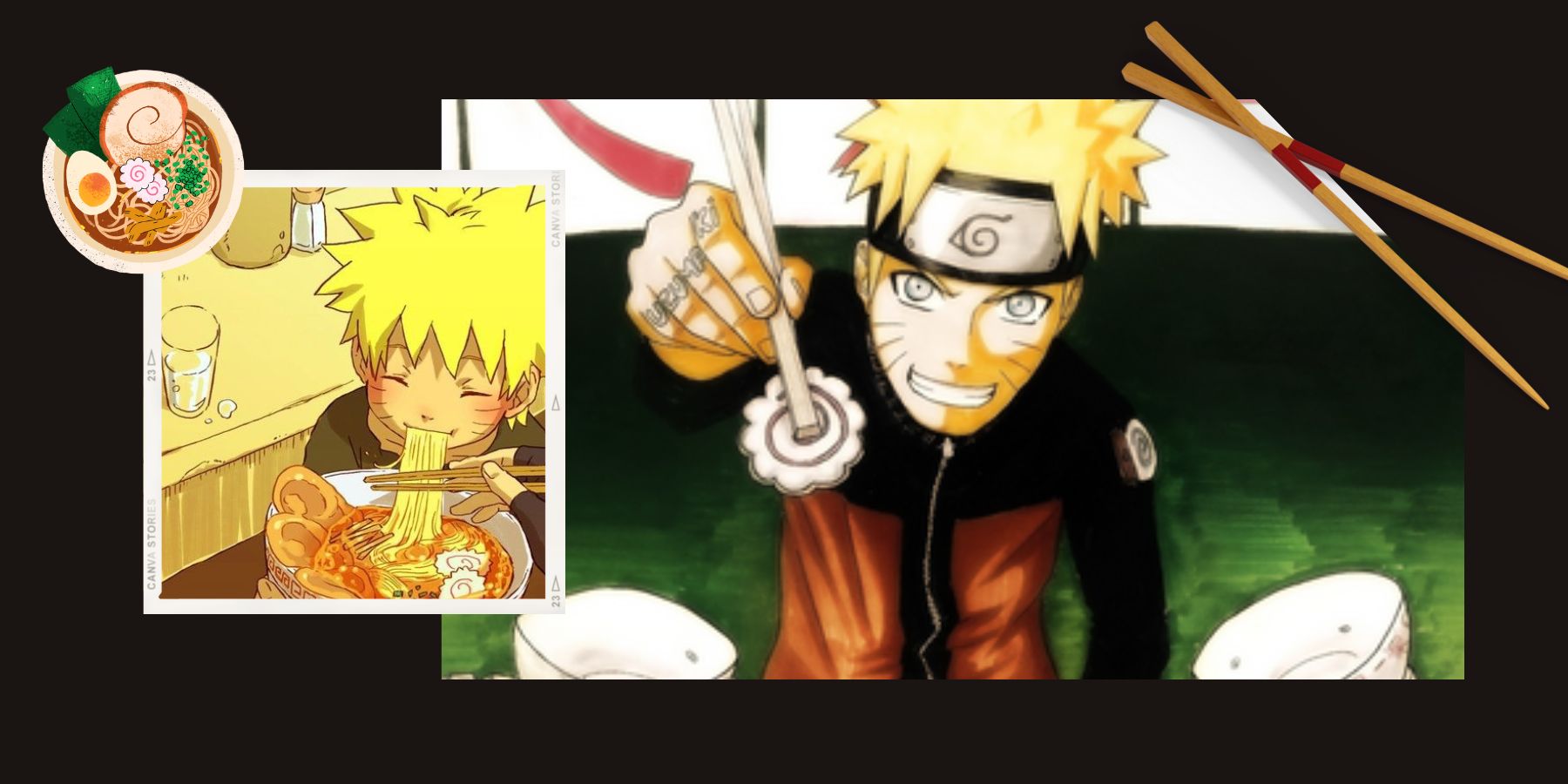
Ramen: Comfort Served In A Bowl
Yes, most people would agree that ramen is essentially comfort served in a soothing and steamy bowl! Comfort food is renowned for bringing solace or a cozy feeling. These are essentially foods that provide psychological, primarily emotional, comfort. In Japan, ramen became popular more than a century ago due to its accessibility and low cost.
Japan and ramen are inseparably linked, with the history of the dish reflecting that of the nation. Ramen is also connected to Naruto in two ways: it is his favorite dish and his comfort food, and the Narutomaki — the traditional Japanese cured fish cake that served as the model for his name — is a common ramen topping.
The phrase “comfort food” is a relatively recent invention, despite the fact that the idea underlying it seems to have been around for all time most of the time. The phrase, which dates back to the 1960s, became well-known in 1977 when one of The Washington Post’s Christmas recipes was dubbed “comfort food.” But it did not create the idea behind the expression. It describes a sentiment that almost all of us share, whether it is one of nostalgia for the food we enjoyed as children, a special meal our grandmothers used to make for us when we were ill or feeling down, or a treat our parents gave us as children.
In the latter half of the 20th century, a number of events contributed to the term “comfort food” becoming widely used. In the beginning, comfort food was simply known as “grandma’s cooking” or “home cooking”—dishes prepared with tender loving care that evoked feelings of nostalgia and warmth.
People lost interest in the kinds of foods that were traditionally thought to be comforting as the food industry expanded and the fast food culture took hold. Fast food appears to have supplanted the handmade food that many people grew up with thanks to its mass-produced flavors and convenience, which led to a rekindling of interest in traditional recipes and cooking methods. People realized that there was something special about the food they grew up with and that these dishes had a special ability to evoke positive emotions.
Also, the growth of social media, food blogs, and food television has given individuals access to a larger variety of international cuisines and dishes.
Hence, comfort food evolved into a word in the twenty-first century that encouraged social interaction through similar memories and customs.
The term “comfort food” has expanded to encompass a variety of dishes and cultural influences, reflecting the complexity and diversity of contemporary society. In both happy and bad times, it is seen to be a means of calming the soul and bringing people together.
Foods high in fatty acids and carbs trigger the brain’s reward center, offering a sense of comfort and pleasure. The fact that our brains are programmed to seek out and be drawn to foods that are high in fat, sugar, and salt is one of the reasons why the reward system in us doesn’t appreciate healthy foods. Foods that are often referred to as “junk food” were created to be extremely tasty and addicting. Dopamine, a neurotransmitter linked to pleasure and reward, is released as a result, creating a joyful experience that increases the urge to consume these foods in the future. Nevertheless, healthful meals like fruits, vegetables, and whole grains may not always produce the same strong pleasurable reaction, which might make it harder for our brains to seek out and appreciate them.
Comfort food activates areas associated with reward and pleasure. Research also shows that the brain regions controlling our mood, memory, and pleasure — the hippocampus, insula, and caudate — become active during food cravings. This explains why anime food, with its appetizing depictions, can so easily influence our desire for delicious snacks. Several blogs and social media accounts now recreate such foods from anime, celebrating their unique delights.
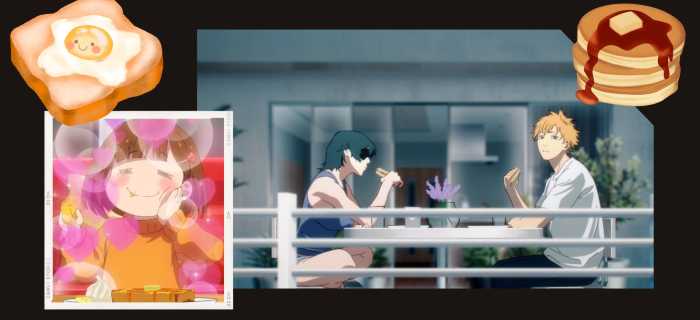
In one particular episode of Chainsaw Man, Denji and Himero have breakfast. This is a shared moment of future happy memories built, and in addition to predicting impending terrible occurrences, it also serves as food for potential future nostalgia. The link between Denji and food in this anime series is a major point in the story. Since the majority of sentimental dishes are either shared with or prepared by cherished ones, the roles performed by nostalgia itself cannot be disregarded. The idea of comfort food is commonly linked to happy experiences and connections. Even if the meal itself was not the best, has some of Denji’s fondest memories of his friend Pochita. Also, Makima used the promise of tasty food as one of her tricks to lure him effortlessly into the world of devil hunting.
Pleasure Systems And Food Wars!
This Winter 2023 anime season, Campfire Cooking In Another World With My Absurd Skill has received high praise for both the enjoyment it provides and the incredibly beautiful food it depicts. Since Mukohda’s talent is a food-related one, this is an isekai cooking anime series that not only shows what appears to be delicious food but also combines ingredients from the fantasy world with those from actual Japan. As a result of the anime’s partnerships with food companies, many of the appealing dishes can be made in real life.
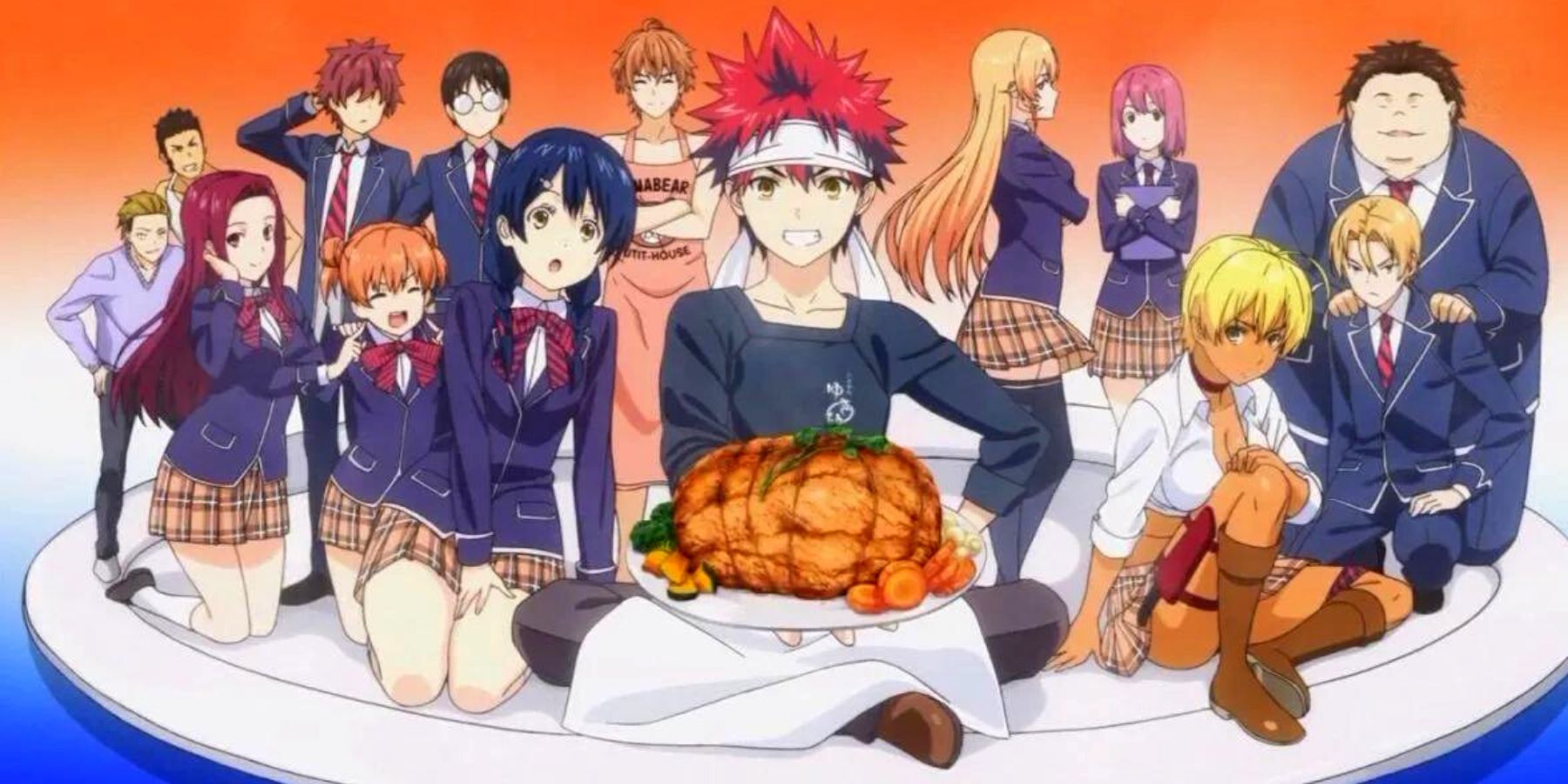
Food Wars! included many sequences of people experiencing foodgasms, which are quite similar to sex orgasms in that they involve people getting undressed and having strong physical reactions to delectable dishes. Both the anime and the manga series, while not without controversy, approached the subject matter with an exaggerated realism that was nonetheless realistic, especially when we take into account how those aforementioned pleasure circuits in our brains function.
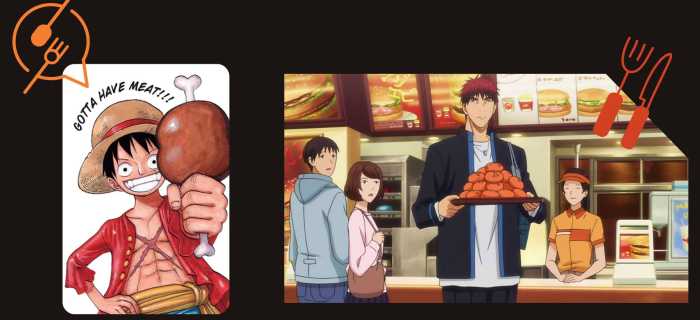
Luffy’s stomach is larger than the average person’s in One Piece, making him need more food to maintain his activities. This explains his ravenous appetite, which is evident from the very first episode of this well-liked and long-running anime series. Luffy also has internal organs that behave like rubber, with a balloon-like elasticity.
In the basketball anime series Kuroko No Basuke, Kagami is frequently seen eating, and there are several plot points where food is significant in this anime series as well. One such instance is when Kagami’s love of food helps the group escape a very dire situation.
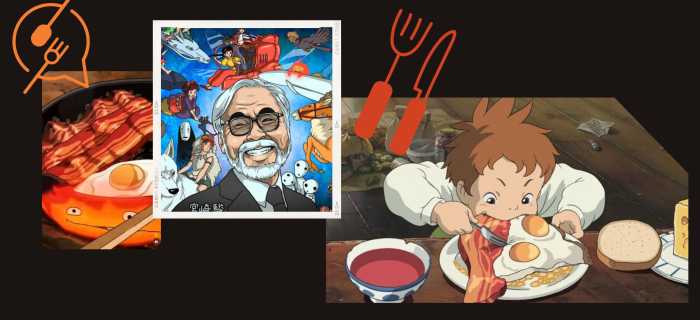
Many people feel that the food portrayed in Makoto Shinkai’s Your Name deserves to be listed among the “Top Ten Foods In Tokyo” due to the mouthwatering ramen with pork and boiled egg, the soft pancakes sprinkled with syrup and topped with a fair bit of pineapple and peach, and a homemade bento box that reminds us of many other bento boxes tenderly prepared in countless other anime series throughout the years.
Due to their shared history and cultural ties to food, South Koreans and Japanese people both place high importance on food. Actually,
South Korea, Japan, and China all share a number of cultural and historical traits in common as East Asian neighbors. Their shared history has long been shaped by food, which is an integral part of their culture. The share of food that these nations have exchanged over time has been impacted by various political and economic circumstances.
The Korean Peninsula developed as a crossroads for the commercial routes connecting China and Japan in the fourth century AD, during the Three Kingdoms period. Many different products, including ginseng, brown rice, and beef, were exported from South Korea.
Raw fish or sushi, ramen, and tempura are all examples of Japanese cuisine, which is heavily influenced by Chinese cooking techniques but also has a distinctive twist all of its own. South Korea is becoming one of Japan’s top importers of fishery products due to the great demand for seafood and fish products there.
Chinese food, on the other hand, is quite complex and diverse, with each region of the nation having its own culinary style. Nonetheless, soy sauce, quick noodles, and frozen dumplings are some of the foods that China exports the most.
Due to what some people saw to be an unnecessary exposure to South Korean cuisine, the South Korean film The Box has received both acclaim and misinterpretation. Furthermore, K-dramas in general frequently feature mouthwatering dishes from South Korean cuisine.
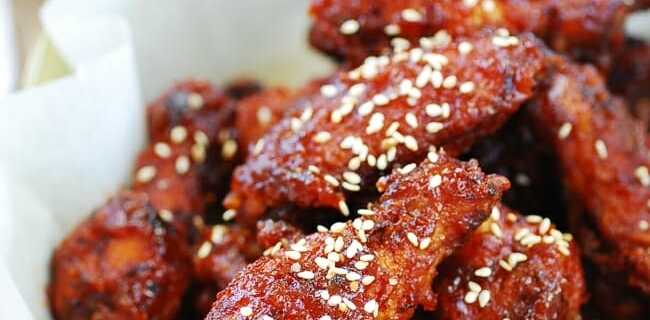
It is simple to imagine that exposure to various cultures and countries’ cuisines is an exaggeration if one is unaware of their histories and cultures. Actually, no. When Western food is portrayed in media, we don’t normally question the diet we are used to, right?
Putting history aside, it all stems from our relationship with food. Of course, food lovers are not just Japanese, Koreans, or even Asians! However, their depiction of food, particularly food in anime, is quite impressive.
What do you think? Leave a comment.











I find it weird in some anime that the characters will very randomly go on a very long and exaggerated rant about whatever food they are eating and some characters who rarely talk very long are suddenly speaking in paragraphs that it feels like a blatant advertizement. Is it a cultural thing? From my perspective, it looks like a lot of artists in Japan spend too much time on detailed food that it is like having a 1 Million polygon object suddenly appearing in Half-Life 1 and you are not supposed to think about it or look at it more than a second.
Thank you for your thoughtful observation! You bring up an interesting point about the prevalence of food in anime and its possible cultural significance. In Japan, food is often viewed as a form of artistic expression and is deeply ingrained in their culture. Therefore, it is not uncommon for anime characters to go on extended rants about the food they are enjoying. While it may seem excessive from an outsider’s perspective, it is a reflection of the cultural importance of food in Japan. Nonetheless, it is understandable that the focus on food can be distracting at times. Thank you for sharing your perspective!
This article just made me hungry.
Ikr? 😛
Actually made me want to make food!
The ghibli food always looks amazing to me, I wanna eat it so bad.
Agree 😉
Something about anime food hits different than real food, even the best real food does NOT COME CLOSE TO THE WORST/NORMAL ANIME FOOD.
I totally agree with you! There’s just something about the way anime food is depicted that makes it look so irresistible. I find myself getting hungry even when I wasn’t before just by watching characters chow down on their animated delicacies. It’s almost magical, don’t you think?
Food Wars is amazing because sometimes the manga will just slap in a recipe for the food they make on one of the blank in-between pages. I made the Chaliapin steak donburi from the battle against Ikumi and it tastes like how it looks – delicious.
Hey there! I couldn’t agree with you more! It’s always a treat to see recipes for the food in Food Wars. I remember trying to make the ramen from Soma’s showdown with Mimasaka and let me tell you, it was an adventure in the kitchen! But it was also so rewarding to taste something that I had seen in the show. And the Chaliapin steak donburi from Ikumi’s battle? That sounds incredible! I might have to try making that one myself. Thanks for sharing your experience and making me hungry! 😋
It still baffles me that the Food Network has never aired any of these food anime. They are so educational it is not even funny.
Anime is like an instagram account for food photography, always pristine! And eggs are great especially in Asian countries, they take special care so they’re clean and safe to eat even raw and use them in most dishes.
We need more japanese food cultural restaurants over here in the United States because of “Ms. Koizumi Loves Ramen Noodles” I actually found a authentic Japanese restaurant I was actually getting tired of eating cheap store brand Ramen noodles cost like 79¢ a pop even my dad like the food and he found a favorite noodle dish and my dad said good gob finding a new place that we can go to.
Top 3 Foods in anime.
1. Curry
2. Sandwich
3. Omelette
This was a delight to read. One of the things in Naruto that I found so adorable was his love of Ramen. When you wrote about it as comfort food, I realized, it says so much about Naruto’s character. He’s a simple and sincere person.
The anime Isekai Shokudou opened my eyes to something I was only dimly aware of from watching Ghibli films, that food in anime is incredible. I started selecting an episode each time I made a great meal so I could sit and watch the chef make something incredible. It would make my meals taste better, look better, be better. It’s so hilariously just food-focused that it’s almost like a cooking show first and an anime second, even though they never show you how to make the food, they just introduce you to dishes and make you want to try them because they looked incredible in Isekai Shokudou. It was fascinating.
The most aesthetically pleasing and delicious anime foods are Hijikata’s Mayonnaise x Rice Special, Gintoki’s Special, and TAKASUGI’S YAKULK COLLECTION.
Tokyo Ghoul made me crave something that is taboo.
So I wonder what time does high school starts in Japan due to the amount of anime character that can actually get up in the morning, cook up an entire meal and still be in time for morning practice(Asa-ren). From my experience it takes several hours alone just to defrost the meat and assuming you don’t slack off for even a second, at least an hour to prepare the vegetables and cook it all up. Like do people in Japan really bring their own lunches or is it just a small percentage of people unlike how it’s portrayed in anime.
Anime food is what food in heaven must look like.
Yeah. Food in cartoons just look ten times better than they do in real life.
Could not agree more 😉
I just recently started watching Food Wars! I’m so far at episode 9 (It’s really good!) And the food in that anime is just so delicious looking omg!
Just full of nostalgia ❤️
Yep ❤️
Whenever I watch naruto and he eats the ramen I just- I suddenly want ramen.
I am eating ramen now 😉
I’ve always wanted to try the real traditional ramen that they have in Naruto.
Relatable.
My mom doesn’t like anime because of the stereotype it has, but I got Netflix on my phone recently and went against her wishes. I have to say that I never regretted it because I’m just amazed at how smooth and fluid the animation is and how each scene is always satisfying to watch when the characters are cooking.
Never knew watching anime could make me want to go and cook immediately, just made me so hungry and iv already eaten😆 only anime can make something as simple as cooking look and feel so epic, adverts should take note.😎
How to make aesthetic food animation:
Step 1: Imagine a scene
Step 2: Try to animate it
Step 3: Come to the realization that you don’t have the skills of a Studio Ghibli animator
Step 4: Cry
Anime will make water look like the most deluxe smoothie in the world.
Always love the comments on a Japanese food type of article. I wonder why other cuisines don’t inspire such cuisine.
Way of the house husband has great food scenes.
Every time I see food in anime I go god dammit stop torturing me it’s been 15 years and I still never had the ramen noodles I’ll never see in my life.
If you think anime food looks so good… you need to visit a Middle Eastern country. They put together some absolutely incredible spreads. Haven’t been to Japan, so not sure if anime is hinting at anything real there…
I am indian and some of u may know that our food doesn’t look raw…(no offense intended ) unlike… for example sushi and other sea foods that were shown in shows like Doraemon (a anime that’s very very popular among kids in india )but the in anime the food drawings always looked like a tasty thing… Especially fried shrimp… But when I grew up and saw that food’s real image I was very disappointed. 🙂
I read this while waiting for my oven bake stuffed crust pizza to finish cooking, and I feel so hungry and sad right now.
Imagine if in attack on Titan we had a food wars moment while a Titan was eating a human lol.
I am big lover of anime series and after reading this blog It recall my childhood memory. Anime food drawn very skillfully that gives you mouth watering feel when you are seeing it. Thank you for sharing this amazing blog.
Pizza in Code Geass made me go out of my way to try to eat pizza only from Pizza Hut for a good year or so.
Im imagining myself having some anime breakfast even tho my breakfast is just some piece of bread without fillings.
Anime artists are so underrated in Japan. They don’t get paid very well and they spent nearly decades perfecting drawing Anime.
I love how most animes that have these ridiculously aesthetic cooking scenes don’t have anything to do with cooking at all and it just pops out of nowhere and you don’t even care about the plot anymore you just want to see more of that aesthetic ramen
I like how this article made me focus on why the food is important when it’s shown on screen as more than a “of course they’re hungry” aspect. Thank you for the reminder of the symbolism different types of food can have in media like anime!
Good to hear that you found the piece insightful and that it sparked a fresh perspective on food symbolism in anime. 🙂
Reading this makes me wonder what if we could just pull out things we wanted from a screen.
You KNOW the anime’s good when you can smell the food from your screen.
I have yet to see an anime character who eats timidly in front of Japanese food. I know it is that good, but they always seemed hungry with all those adventures. Cooking Master Boy always beats Gordon Ramsay’s Iron Chef anytime. Would like to see a spin-off of all those Japanese masters. Hey, I should write an article about it now.
I agree food is one of the many perks of life. They symbolize many things, including emotions, comfort and pleasure. Anime does a good job depicting the symbolism of food and how it affects the human spirit.
Great article! Love the eggs on toast scene from Castle in the Sky.
This is so interesting — a wonderfully written article. A few thoughts to add:
The cultural “translation” of uncommon foods:
What comes to mind immediately is the “translation” of onigiri to jelly-filled donuts in Pokemon. These sorts of laziness are sad and rob viewers of that cultural exposure.
However, in some cases, food items are changed to have the same intended impact on different global audiences. In “Inside Out,” the American version features broccoli on pizza. In the Japanese version, the toppings are green bell peppers, which are apparently a common “kids won’t eat” food in Japan.
Food is universal, but dishes are not. I think that it’s interesting to watch how global audiences perceive and receive food in media.
I think the use of food in anime is–perhaps unintentionally– a marketing tactic of sorts. Who doesn’t get captivated or more engrossed in an image or video when it activates their appetite, a basic human desire?
You hit the nail on the head at the very beginning. Food is so important for several reasons. First, it is the way we share our lives with others. By sharing good food with a friend, we share a piece of ourselves. Second, eating is shared human experience. Everyone understands the pleasure felt when experiencing an incredible meal, especially in good company.